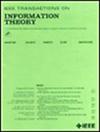Overparameterized ReLU Neural Networks Learn the Simplest Model: Neural Isometry and Phase Transitions
IF 2.2
3区 计算机科学
Q3 COMPUTER SCIENCE, INFORMATION SYSTEMS
引用次数: 0
Abstract
The practice of deep learning has shown that neural networks generalize remarkably well even with an extreme number of learned parameters. This appears to contradict traditional statistical wisdom, in which a trade-off between model complexity and fit to the data is essential. We aim to address this discrepancy by adopting a convex optimization and sparse recovery perspective. We consider the training and generalization properties of two-layer ReLU networks with standard weight decay regularization. Under certain regularity assumptions on the data, we show that ReLU networks with an arbitrary number of parameters learn only simple models that explain the data. This is analogous to the recovery of the sparsest linear model in compressed sensing. For ReLU networks and their variants with skip connections or normalization layers, we present isometry conditions that ensure the exact recovery of planted neurons. For randomly generated data, we show the existence of a phase transition in recovering planted neural network models, which is easy to describe: whenever the ratio between the number of samples and the dimension exceeds a numerical threshold, the recovery succeeds with high probability; otherwise, it fails with high probability. Surprisingly, ReLU networks learn simple and sparse models that generalize well even when the labels are noisy. The phase transition phenomenon is confirmed through numerical experiments.求助全文
约1分钟内获得全文
求助全文
来源期刊

IEEE Transactions on Information Theory
工程技术-工程:电子与电气
CiteScore
5.70
自引率
20.00%
发文量
514
审稿时长
12 months
期刊介绍:
The IEEE Transactions on Information Theory is a journal that publishes theoretical and experimental papers concerned with the transmission, processing, and utilization of information. The boundaries of acceptable subject matter are intentionally not sharply delimited. Rather, it is hoped that as the focus of research activity changes, a flexible policy will permit this Transactions to follow suit. Current appropriate topics are best reflected by recent Tables of Contents; they are summarized in the titles of editorial areas that appear on the inside front cover.
 求助内容:
求助内容: 应助结果提醒方式:
应助结果提醒方式:


